+ Open data
Open data
- Basic information
Basic information
| Entry | Database: PDB / ID: 6ayf | ||||||||||||||||||||||||||||||
|---|---|---|---|---|---|---|---|---|---|---|---|---|---|---|---|---|---|---|---|---|---|---|---|---|---|---|---|---|---|---|---|
| Title | TRPML3/ML-SA1 complex at pH 7.4 | ||||||||||||||||||||||||||||||
 Components Components | Mucolipin-3 | ||||||||||||||||||||||||||||||
 Keywords Keywords |  TRANSPORT PROTEIN / TRANSPORT PROTEIN /  ion channel / ion channel /  TRP channel / TRP channel /  lysosomal lysosomal | ||||||||||||||||||||||||||||||
| Function / homology |  Function and homology information Function and homology informationNAADP-sensitive calcium-release channel activity / inner ear auditory receptor cell differentiation /  TRP channels / autophagosome membrane / locomotory behavior / calcium ion transmembrane transport / TRP channels / autophagosome membrane / locomotory behavior / calcium ion transmembrane transport /  calcium channel activity / late endosome membrane / early endosome membrane / lysosomal membrane ...NAADP-sensitive calcium-release channel activity / inner ear auditory receptor cell differentiation / calcium channel activity / late endosome membrane / early endosome membrane / lysosomal membrane ...NAADP-sensitive calcium-release channel activity / inner ear auditory receptor cell differentiation /  TRP channels / autophagosome membrane / locomotory behavior / calcium ion transmembrane transport / TRP channels / autophagosome membrane / locomotory behavior / calcium ion transmembrane transport /  calcium channel activity / late endosome membrane / early endosome membrane / lysosomal membrane / calcium channel activity / late endosome membrane / early endosome membrane / lysosomal membrane /  lipid binding / lipid binding /  plasma membrane plasma membraneSimilarity search - Function | ||||||||||||||||||||||||||||||
| Biological species |   Homo sapiens (human) Homo sapiens (human) | ||||||||||||||||||||||||||||||
| Method |  ELECTRON MICROSCOPY / ELECTRON MICROSCOPY /  single particle reconstruction / single particle reconstruction /  cryo EM / Resolution: 3.62 Å cryo EM / Resolution: 3.62 Å | ||||||||||||||||||||||||||||||
 Authors Authors | Zhou, X. / Li, M. / Su, D. / Jia, Q. / Li, H. / Li, X. / Yang, J. | ||||||||||||||||||||||||||||||
| Funding support |  China, China,  United States, 9items United States, 9items
| ||||||||||||||||||||||||||||||
 Citation Citation |  Journal: Nat Struct Mol Biol / Year: 2017 Journal: Nat Struct Mol Biol / Year: 2017Title: Cryo-EM structures of the human endolysosomal TRPML3 channel in three distinct states. Authors: Xiaoyuan Zhou / Minghui Li / Deyuan Su / Qi Jia / Huan Li / Xueming Li / Jian Yang /   Abstract: TRPML3 channels are mainly localized to endolysosomes and play a critical role in the endocytic pathway. Their dysfunction causes deafness and pigmentation defects in mice. TRPML3 activity is ...TRPML3 channels are mainly localized to endolysosomes and play a critical role in the endocytic pathway. Their dysfunction causes deafness and pigmentation defects in mice. TRPML3 activity is inhibited by low endolysosomal pH. Here we present cryo-electron microscopy (cryo-EM) structures of human TRPML3 in the closed, agonist-activated, and low-pH-inhibited states, with resolutions of 4.06, 3.62, and 4.65 Å, respectively. The agonist ML-SA1 lodges between S5 and S6 and opens an S6 gate. A polycystin-mucolipin domain (PMD) forms a luminal cap. S1 extends into this cap, forming a 'gating rod' that connects directly to a luminal pore loop, which undergoes dramatic conformational changes in response to low pH. S2 extends intracellularly and interacts with several intracellular regions to form a 'gating knob'. These unique structural features, combined with the results of electrophysiological studies, indicate a new mechanism by which luminal pH and other physiological modulators such as PIP regulate TRPML3 by changing S1 and S2 conformations. | ||||||||||||||||||||||||||||||
| History |
|
- Structure visualization
Structure visualization
| Movie |
 Movie viewer Movie viewer |
|---|---|
| Structure viewer | Molecule:  Molmil Molmil Jmol/JSmol Jmol/JSmol |
- Downloads & links
Downloads & links
- Download
Download
| PDBx/mmCIF format |  6ayf.cif.gz 6ayf.cif.gz | 394.2 KB | Display |  PDBx/mmCIF format PDBx/mmCIF format |
|---|---|---|---|---|
| PDB format |  pdb6ayf.ent.gz pdb6ayf.ent.gz | 321.9 KB | Display |  PDB format PDB format |
| PDBx/mmJSON format |  6ayf.json.gz 6ayf.json.gz | Tree view |  PDBx/mmJSON format PDBx/mmJSON format | |
| Others |  Other downloads Other downloads |
-Validation report
| Arichive directory |  https://data.pdbj.org/pub/pdb/validation_reports/ay/6ayf https://data.pdbj.org/pub/pdb/validation_reports/ay/6ayf ftp://data.pdbj.org/pub/pdb/validation_reports/ay/6ayf ftp://data.pdbj.org/pub/pdb/validation_reports/ay/6ayf | HTTPS FTP |
|---|
-Related structure data
| Related structure data |  7019MC  7018C  7020C  6ayeC  6aygC M: map data used to model this data C: citing same article ( |
|---|---|
| Similar structure data |
- Links
Links
- Assembly
Assembly
| Deposited unit | 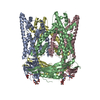
|
|---|---|
| 1 |
|
- Components
Components
| #1: Protein | Mass: 64625.785 Da / Num. of mol.: 4 Source method: isolated from a genetically manipulated source Source: (gene. exp.)   Homo sapiens (human) / Gene: MCOLN3 / Plasmid: pFastbac1 / Production host: Homo sapiens (human) / Gene: MCOLN3 / Plasmid: pFastbac1 / Production host:   Trichoplusia ni (cabbage looper) / References: UniProt: Q8TDD5 Trichoplusia ni (cabbage looper) / References: UniProt: Q8TDD5#2: Sugar | ChemComp-NAG /  N-Acetylglucosamine N-Acetylglucosamine |
|---|
-Experimental details
-Experiment
| Experiment | Method:  ELECTRON MICROSCOPY ELECTRON MICROSCOPY |
|---|---|
| EM experiment | Aggregation state: PARTICLE / 3D reconstruction method:  single particle reconstruction single particle reconstruction |
- Sample preparation
Sample preparation
| Component | Name: TRPML3 channel bound with a agonist ML-SA1 / Type: COMPLEX / Entity ID: #1 / Source: RECOMBINANT | ||||||||||||||||||||
|---|---|---|---|---|---|---|---|---|---|---|---|---|---|---|---|---|---|---|---|---|---|
| Molecular weight | Experimental value: NO | ||||||||||||||||||||
| Source (natural) | Organism:   Homo sapiens (human) Homo sapiens (human) | ||||||||||||||||||||
| Source (recombinant) | Organism:   Trichoplusia ni (cabbage looper) Trichoplusia ni (cabbage looper) | ||||||||||||||||||||
| Buffer solution | pH: 7.4 / Details: ML-SA1 was added before sample was frozen. | ||||||||||||||||||||
| Buffer component |
| ||||||||||||||||||||
| Specimen | Conc.: 1.9 mg/ml / Embedding applied: NO / Shadowing applied: NO / Staining applied : NO / Vitrification applied : NO / Vitrification applied : YES : YES | ||||||||||||||||||||
| Specimen support | Grid material: COPPER / Grid mesh size: 400 divisions/in. / Grid type: Quantifoil holey carbon grid R1.2/1.3 | ||||||||||||||||||||
Vitrification | Instrument: FEI VITROBOT MARK IV / Cryogen name: ETHANE / Humidity: 100 % / Chamber temperature: 281 K |
- Electron microscopy imaging
Electron microscopy imaging
| Experimental equipment |  Model: Titan Krios / Image courtesy: FEI Company |
|---|---|
| Microscopy | Model: FEI TITAN KRIOS |
| Electron gun | Electron source : :  FIELD EMISSION GUN / Accelerating voltage: 300 kV / Illumination mode: SPOT SCAN FIELD EMISSION GUN / Accelerating voltage: 300 kV / Illumination mode: SPOT SCAN |
| Electron lens | Mode: BRIGHT FIELD Bright-field microscopy / Nominal defocus max: 2500 nm / Nominal defocus min: 1000 nm / Cs Bright-field microscopy / Nominal defocus max: 2500 nm / Nominal defocus min: 1000 nm / Cs : 2.7 mm / Alignment procedure: COMA FREE : 2.7 mm / Alignment procedure: COMA FREE |
| Specimen holder | Cryogen: NITROGEN / Specimen holder model: FEI TITAN KRIOS AUTOGRID HOLDER |
| Image recording | Average exposure time: 8 sec. / Electron dose: 50 e/Å2 / Detector mode: SUPER-RESOLUTION / Film or detector model: GATAN K2 SUMMIT (4k x 4k) |
| Image scans | Width: 7676 / Height: 7420 / Movie frames/image: 32 / Used frames/image: 1-32 |
- Processing
Processing
| EM software |
| ||||||||||||||||||||||||||||||||||||||||
|---|---|---|---|---|---|---|---|---|---|---|---|---|---|---|---|---|---|---|---|---|---|---|---|---|---|---|---|---|---|---|---|---|---|---|---|---|---|---|---|---|---|
CTF correction | Type: NONE | ||||||||||||||||||||||||||||||||||||||||
| Symmetry | Point symmetry : C4 (4 fold cyclic : C4 (4 fold cyclic ) ) | ||||||||||||||||||||||||||||||||||||||||
3D reconstruction | Resolution: 3.62 Å / Resolution method: FSC 0.143 CUT-OFF / Num. of particles: 50726 / Symmetry type: POINT |
 Movie
Movie Controller
Controller



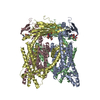

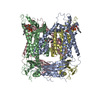
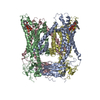
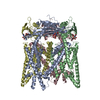
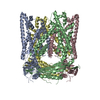

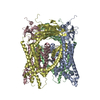
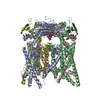
 PDBj
PDBj

